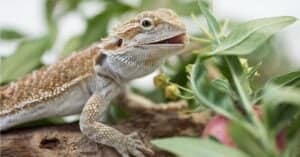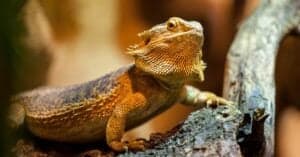The bearded dragon, also affectionately known as the beardie among reptile hobbyists, is one of the world’s most popular and beloved pet reptiles. Its docile, curious temperament combined with its hardy nature and straightforward, manageable care requirements make it a delightful scaly companion even for a beginner. But certain aspects of your beardie’s care must be managed carefully and correctly for your reptile pal to live their life to the fullest, such as the temperature and humidity levels in your bearded dragon’s tank.
Below, we’ll take an in-depth look at the correct humidity levels for your bearded dragon, how to achieve and maintain the proper humidity, and why it’s so important. Read on to learn everything you need to know about this crucial aspect of your reptile pet’s care.
What is the Ideal Humidity Level For a Bearded Dragon?

Maintaining correct, consistent humidity levels is crucial to your bearded dragon’s health and comfort.
©iStock.com/huettenhoelscher
To keep your bearded dragon happy and healthy, the ideal humidity level you should strive to maintain for their enclosure is between 30 and 40 percent. As desert lizards native to Australia, their humidity requirements are fairly low compared to many other pet reptiles. Still, they do need some moisture in the air to survive and thrive.
There are a few different ways you can achieve and maintain this level of humidity, such as misting your bearded dragon and its enclosure with water by hand or using automatic, timed devices to mist the tank. Humidity gauges designed for reptile enclosures can also help you monitor the enclosure’s levels at a glance. We’ll cover these methods in more detail below, as well as why your beardie needs a specific humidity level in the first place.
Why Do Bearded Dragons Need Humidity?

Because they are
desert
animals, bearded dragons fare best in relatively low humidity.
©iStock.com/Paul Oborowski
Achieving and maintaining proper humidity levels is important to both your bearded dragon’s happiness and health. Bearded dragons are native to Australia’s deserts, savannas, and scrublands. In their native habitat, conditions are usually very hot with low humidity. For your scaly friend to truly thrive in captivity, you’ll need to carefully replicate these conditions as closely as possible.
Without the correct humidity levels, your bearded dragon will not only be uncomfortable and unhappy but can suffer health issues as well. If the humidity is too high, for instance, harmful bacteria can grow and spread. Additionally, your pet can breathe in too much moisture, resulting in it becoming trapped in their lungs and causing a respiratory infection.
Unfortunately, respiratory infections caused by improper humidity levels are common among these lizards. In most cases, they can be treated with antibiotics, but they are also very stressful and uncomfortable for bearded dragons and can result in death if not treated quickly.
But if the humidity in your bearded dragon’s tank gets too low, problems can also arise. After all, humidity helps your beardie grow and shed their skin properly.
Without the correct amount of moisture in the air, your pet can develop dysecdysis, or stuck shed, a condition where their skin does not fully shed and fall off. This stuck skin can be uncomfortable, itchy, and even painful. It can also result in loss of circulation to delicate areas like the tip of the tail and claws. If left untreated, your beardie can lose parts of its tail or limbs or even develop more harmful skin infections.
Let’s move on, then, to how you can first achieve and then maintain the correct humidity levels for your beardie.
How to Monitor the Humidity in Your Bearded Dragon’s Enclosure
As we covered above, you’ll need to strive to maintain a consistent humidity level of between 30 and 40 percent for your bearded dragon’s tank. Before you’re able to properly achieve and maintain this humidity level, however, you’ll need to figure out how to monitor it. The first thing you’ll need to be able to monitor what the humidity level is in the enclosure is a humidity gauge or a hygrometer.
It’s a good idea to have at least one hygrometer in your bearded dragon’s enclosure. Ideally, you should mount the hygrometer on the wall of the tank somewhere in the middle. This way, you can get a good average reading of the enclosure’s levels. Both digital and analog hygrometers exist, though digital is best for correct readings. After you’ve set up and mounted the hygrometer, you’ll be able to easily glance at it from time to time for a reading.
Once you’ve gotten the first humidity reading in your bearded dragon’s enclosure, you can move on to either lowering or raising the levels to suit your pet’s needs.
Keep in mind it can take some experimenting to figure out what works best for you and your pet’s enclosure, as conditions can vary from home to home. This is why it’s best to fully set up your bearded dragon’s enclosure with the correct temperature and humidity before bringing your pet home.
Achieving and Maintaining the Proper Humidity For Your Bearded Dragon

You can use a hygrometer to monitor the humidity in your bearded dragon’s enclosure.
©iStock.com/JeannetteKatzir
Now that you have your bearded dragon’s enclosure set up and the first reading on your hygrometer, you can get the settings just right for your pet! The humidity will likely either be a bit too low or too high, so let’s address how to remedy both situations below.
If the humidity is too low, the best thing to do is simply mist the enclosure manually with a bit of water. You can also use automatic, timed misters, but make sure you don’t have it set to mist the tank too often. For animals like bearded dragons that require fairly low humidity, not much-repeated misting is required.
Moving your bearded dragon’s water dish a bit closer to its heat source can also help release more water vapor into the air, resulting in increased humidity. However, you will need to refill the water dish more often, as the water will evaporate more quickly.
On the other hand, if the humidity is too high in the tank, there are a few measures you can take to lower it. Instead of moving the water dish closer to the heat lamp, you can try moving it slightly further away to reduce the amount of water in the air. Increasing ventilation to the enclosure and the room the tank is kept in can also help.
Additionally, certain loose substrates can hold more water than others. Switching to something that retains less moisture such as flat tiles can further lower the humidity in your beardie’s enclosure.
As we touched on earlier, you will likely need to experiment a bit to get the humidity reading within that ideal range of 30 to 40 percent. Be sure to check your hygrometer often!
The photo featured at the top of this post is © iStock.com/huettenhoelscher
Thank you for reading! Have some feedback for us? Contact the AZ Animals editorial team.







